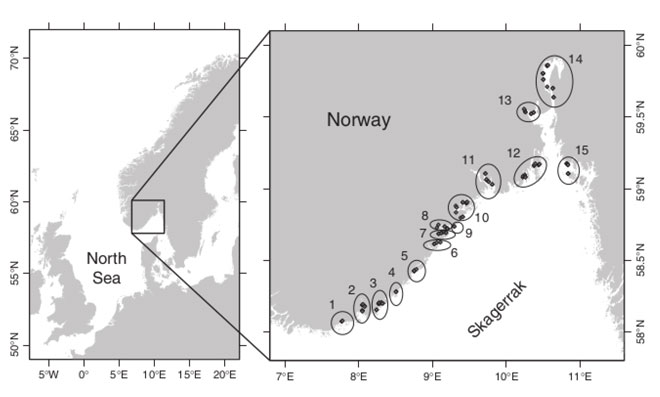About the project
This multidisciplinary project addresses the fundamental question of how coastal ecosystems and their constituent species are structured spatially and what is the appropriate scale of management of coastal ecosystems.
We approach this question by applying the latest genomic tools (ddRAD and full-genome re-sequencing) to characterize the spatial scale of genetic population structure, including local adaptations, and to decipher historical patterns of major demographic events. This genomic approach is complemented by spatial population dynamical analyses of unique long-term (60+ years) adundance data to test if the spatial scale of population dynamics matches that of genetic structure. This comparative approach is extended to multiple species representing all trophic levels, from plants to apex predators, within a common coastal range.
We will include 12 or 13 species in the analyzes, most of which have a reference genome, to tests for similarities in spatial scale of structuring, genetically and dynamically. We hypothesize that the scale in species at trophic levels similar and imposed by common structuring forces including ocean currents, thereby indicating an appropriate scale of management of coastal ecosystems.
Objectives
Primary:
Characterize the appropriate spatial scale of management of coastal ecosystems.
Secondary:
1) Characterize spatial patterns of genetic structure within species in coastal ecosystems and test if they correlate with environmental variables such as ocean currents and bottom habitats
2) Characterize spatial patterns of population dynamics within species in coastal ecosystems and test if they match the species' genetic patterns
3) Detect local adaptations at the genomic level and characterize their geographic distribution and gene functions
4) Reconstruct demographic histories for coastal species from genomic patterns and characterize long-term stability of coastal species assemblies and ecosystems
5) Use comparative analyses of population genetic, demographic, and adaptive structure among several species across trophic levels to detect common structuring mechanisms in coastal ecosystems
6) From these findings, elucidate the appropriate scale of management of coastal ecosystems

Map of main study area in Skagerrak, with sample stations (dots). Numbered circles indicate one option for clustering sample stations based on proximity (from Rogers et al. 2017).
Financing
This Project is funded by the Research Council of Norway (RCN) (MARINFORSK) through the Institute of Marine Research
RCN Project Number: 280453 (Project data bank at RCN)
UiO Project Number: 190774
Period
01.04.2018 - 30.09.2022